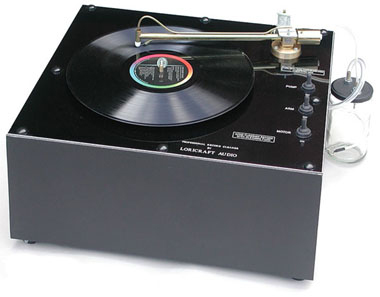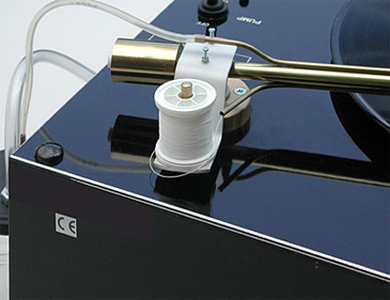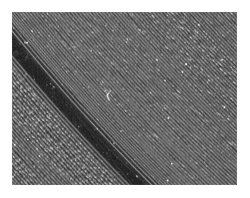You are reading the older HTML site
Positive Feedback ISSUE
15
september/october 2004
loricraft audio
PRC-3F Record Cleaner
as reviewed by Danny Kaey

|
DANNY KAEY'S SYSTEM LOUDSPEAKERS ELECTRONICS SOURCES CABLES
|
I have been an avid record collector for the past year and a half, and have amassed some 400 vinyl treasures, mostly through a local monthly swap meet, though I have gotten some LPs from eBay. While I really enjoy the atmosphere of the swap meet—not to mention the fact that I usually save quite a bit of money by avoiding shipping charges—the records I find on eBay are sometimes very special indeed. Unfortunately, when I play my new purchases, I often hear noise, noise, and more noise. Though I never imagined that I would own a significant number of records, as my collection grows, I realize that at some point I will have to face reality and purchase a record cleaning machine.
Doing a little bit of research, I discovered that the only effective way to clean LPs is by the so-called wet method. The idea is simple: You apply a specially formulated cleaning fluid generously with a brush, then vacuum up the grit, dirt, and whatever else has been living in the microscopic grooves of your favorite records. It sounds simple enough, though the proper execution of this method is what separates the real record cleaning men from the girlie men. Upon further investigation, I found that there are only a handful of companies offering reliable machines, at a wide variety of price points.
Both Nitty Gritty and VPI make solid, entry-level record cleaning machines starting at a price of around $200 for the basic Nitty Gritty. The upper end of the price scale includes products like the German-made Clearaudio at around $3000 and the (relatively) more sanely priced, British-made Loricraft at $1800. The Keith Monks machine has often been heralded as the best record cleaning device ever produced, but since it is no longer available, the Loricraft PRC-3F, which is based upon the Keith Monks, may be the best record cleaning machine you can buy.
Most record cleaning machines have a "plinth" which houses the suction device and motor assembly, a platter, and a suction device that swings across one half of the record. A canister to take up all the dirt and fluid usually resides somewhere close by, for removal of waste. You wet the record with your cleaning solution, turn on the motor, and move the obnoxiously loud vacuum device across the record. A few revolutions later, all the dirt has (hopefully!) been removed from the record, restoring it to newfound glory. The Loricraft differs from most other designs (except for the Keith Monks, which it pretty much duplicates) in employing what appears to be a pivoted tonearm. This arm, made of brass, houses the high-pressure vacuum line that travels across the record in much the same way a tonearm does. The final, ingenious twist to the design is a fine cotton thread that is routed, via a small brass tube on top of the arm, to the suction tip. At the other end, the tube is routed back to the glass container in which the excess fluids are dumped.

The point of all this is that each time you clean a record, the thread absorbs all of the dirt that it has just been picked up from your cherished record, and the dirty section of thread is deposited, along with the dirty fluid, in the glass container. Most other machines (again, the exception is the Keith Monks) employ a brush in conjunction with the suction device. The dirt removed from the record collects on the brush, and unless you periodically take the suction device apart and clean it, the brush will contaminate each successive record with the remains of the previous jobs. Now you can understand my excitement when Loricraft's U.S. importer, Smart Devices, asked me if I was interested in spending some time with the PRC-3F.
The Keith Monks machine dates back to the 60s (I've asked this question before—where has all the progress gone?), when Percy Wilson, British Grammophone magazine editor at the time, showed the public a working prototype of this now classic design. Loricraft has, of course, updated the design with modern manufacturing technologies, particularly advances in motor design. The Loricraft machines are hand made in England, using only but the best parts. The machine is covered under a five-year warranty, though after spending a month with it, I honestly can't see how anything could go wrong with so solid and superb a design.
Let me say from the start that the
Loricraft machine is the only one with which I have spent significant time,
and that I know about the others only from observance and trade show demos.
Nevertheless, it was immediately clear to me that this machine is quite
special. The setup and operation are as simple as can be, though a bit
nervous at first, I cleaned a beaten-up copy of a Dean Martin record just in
case I screwed up. I had never had a chance to wet clean the record, and
sincerely doubt that the previous owner knew anything about wet cleaning.
Before cleaning it, the results were as expected—ticks, pops, and other
noises made their way through the speakers. I placed the record on the
Loricraft's platter, washed it with the supplied brush and the also-supplied
medium-weight record cleaning fluid, and lowered the suction arm over the
record. This is where one of the most attractive attributes of the Loricraft
machine surfaced. The suction motor was so powerful, yet so quiet, that I
could carry on a telephone conversation while hovering over the Loricraft
cleaning the record! This was truly a remarkable feat, and one that I think
is unique to the Loricraft. I decided to clean only the first side of the
Dean Martin record to have a reference point. I placed the visibly shiny,
squeaky-clean side A onto my Brinkmann turntable and rushed back to my seat
to hear the opening track.
Truth be told, I did not expect the Loricraft to provide no-noise playback. Boy, was I in for a surprise! The noise, ticks, and pops had vanished to the point of allowing me to hear Dino's voice with newfound clarity and dynamics. I simply couldn't believe this was the same record that sounded so worn prior to the wash. Sure enough, side B proved the point—whoosh, tick, pop, whoosh, tick pop! I flipped the record to side A one more time, to make sure I wasn't imagining things, and indeed I wasn't—the noise was diminished to non-obtrusiveness!
I immediately took out some twenty of my favorite LPs and gave them the wet wash they deserved. Time after time, the Loricraft did a superb job of deep cleaning them to the point that noise became a secondary issue. Was this the cure for cancer? No, some of my records simply couldn't be returned to life, no matter how often I cleaned them. Obviously, stylus wear, incorrect turntable setup, and the recklessness of previous owners all play a part in playback quality. If a record is too damaged, not even the Loricraft can work its magic. What it does do very well, however, is eliminate the contaminants. Even brand new, sealed records benefit from the Loricraft. Residue that remains on the record surface after pressing can be washed away for cleaner, better performance.
What the Loricraft does very well, and most importantly, time after time, is a result of the idea of running thread between the suction tip and the LP surface, thus providing a clean surface to absorb the dirt picked up from the record. I have never encountered another record cleaning machine that does that, so the Loricraft leads the pack on that very important point. Since I didn't have access to other machines, I am not in the position to make statements about their comparative success or failure in cleaning records. On the other hand, I know enough about the design concept of the Loricraft to know how it differs from other such products. Do those differences make it better? I honestly can't say, though other machines—even more expensive ones—seem almost crude by comparison. At the recently increased retail price of $1895, you get a machine that no vinyl-loving audiophile should be without. For an extra $200, you can even specify a walnut, mahagony, teak, or English ash cabinet (the standard model is black). Sure, a starter machine that costs less than $300 will do the trick, but why bother spending $4K on a Tri-Planar tonearm when a Rega 250 also plays music? The cheaper record cleaning machine will not only be much louder, but it will also be entirely manual in its operation, making LP cleaning much more of a chore.
In the end, it depends on your preferences, and whether you wish to have the best possible source—a professionally cleaned record. A single demonstration of the simple and elegant Loricraft PRC-3F will leave many record lovers longing for it. At almost $2K, the Loricraft is much more expensive than other well-known machines, though it is by no means the most expensive (the Clearaudio is around $3K, and the Keith Monks, when available, was considerably more!). That's just a formality, in my opinion. After using the Loricraft, I simply cannot imagine going back to Dustbuster-style vacuum cleaners—they really are that LOUD! Even more important, the ingeniousness of the Loricraft's self-cleaning design ensures that you will have a clean, fresh record each time you use it, and that alone makes it hard to beat. Danny Kaey
Loricraft Audio
web address:
www.smartdev.com/loricraft.html
